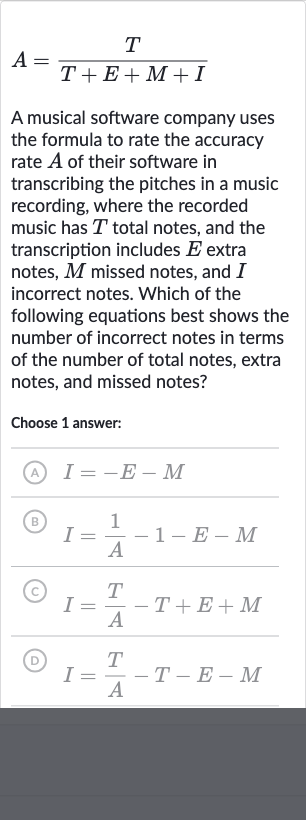AI tutor
Welcome to Bytelearn!
Let’s check out your problem:

A musical software company uses the formula to rate the accuracy rate of their software in transcribing the pitches in a music recording, where the recorded music has total notes, and the transcription includes extra notes, missed notes, and incorrect notes. Which of the following equations best shows the number of incorrect notes in terms of the number of total notes, extra notes, and missed notes?Choose answer:(A) (B) (C) (D)
Full solution
Q. A musical software company uses the formula to rate the accuracy rate of their software in transcribing the pitches in a music recording, where the recorded music has total notes, and the transcription includes extra notes, missed notes, and incorrect notes. Which of the following equations best shows the number of incorrect notes in terms of the number of total notes, extra notes, and missed notes?Choose answer:(A) (B) (C) (D)
- Rewrite formula: We start by rewriting the given formula for accuracy rate A:Our goal is to solve for I in terms of T, E, and M.
- Multiply by denominator: First, we multiply both sides of the equation by the denominator to get rid of the fraction:
- Distribute A: Next, we distribute A across the terms in the parentheses:
- Isolate I: Now, we want to isolate I on one side of the equation. To do this, we subtract AT, AE, and AM from both sides:
- Factor out T: We factor out T from the terms on the right side of the equation:
- Divide by A: Finally, we divide both sides by A to solve for I:
- Simplify equation: Simplify the equation by dividing each term on the right side by A:This matches option (D) from the given choices.
More problems from Solve rational equations
QuestionGet tutor help
